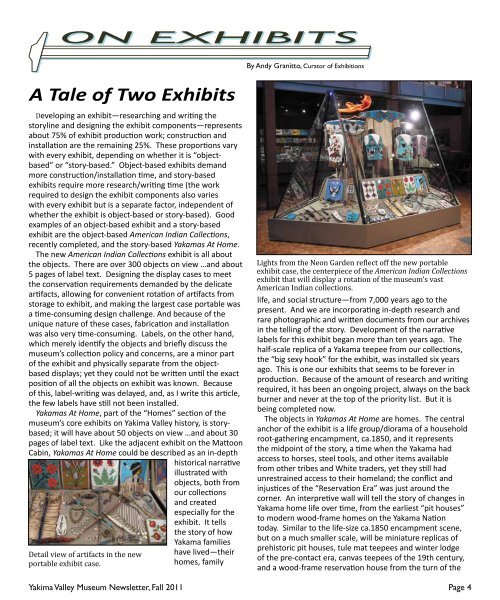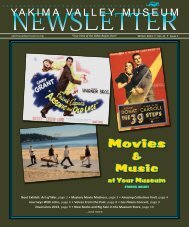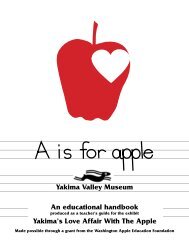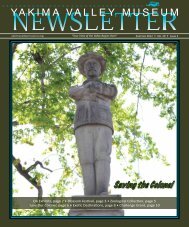Yakima Valley Museum Newsletter
Yakima Valley Museum Newsletter
Yakima Valley Museum Newsletter
Create successful ePaper yourself
Turn your PDF publications into a flip-book with our unique Google optimized e-Paper software.
ON EXHIBITS<br />
A Tale of Two Exhibits<br />
Developing an exhibit—researching and writing the<br />
storyline and designing the exhibit components—represents<br />
about 75% of exhibit production work; construction and<br />
installation are the remaining 25%. These proportions vary<br />
with every exhibit, depending on whether it is “objectbased”<br />
or “story-based.” Object-based exhibits demand<br />
more construction/installation time, and story-based<br />
exhibits require more research/writing time (the work<br />
required to design the exhibit components also varies<br />
with every exhibit but is a separate factor, independent of<br />
whether the exhibit is object-based or story-based). Good<br />
examples of an object-based exhibit and a story-based<br />
exhibit are the object-based American Indian Collections,<br />
recently completed, and the story-based Yakamas At Home.<br />
The new American Indian Collections exhibit is all about<br />
the objects. There are over 300 objects on view …and about<br />
5 pages of label text. Designing the display cases to meet<br />
the conservation requirements demanded by the delicate<br />
artifacts, allowing for convenient rotation of artifacts from<br />
storage to exhibit, and making the largest case portable was<br />
a time-consuming design challenge. And because of the<br />
unique nature of these cases, fabrication and installation<br />
was also very time-consuming. Labels, on the other hand,<br />
which merely identify the objects and briefly discuss the<br />
museum’s collection policy and concerns, are a minor part<br />
of the exhibit and physically separate from the objectbased<br />
displays; yet they could not be written until the exact<br />
position of all the objects on exhibit was known. Because<br />
of this, label-writing was delayed, and, as I write this article,<br />
the few labels have still not been installed.<br />
Yakamas At Home, part of the “Homes” section of the<br />
museum’s core exhibits on <strong>Yakima</strong> <strong>Valley</strong> history, is storybased;<br />
it will have about 50 objects on view …and about 30<br />
pages of label text. Like the adjacent exhibit on the Mattoon<br />
Cabin, Yakamas At Home could be described as an in-depth<br />
historical narrative<br />
illustrated with<br />
objects, both from<br />
our collections<br />
and created<br />
especially for the<br />
exhibit. It tells<br />
the story of how<br />
Yakama families<br />
Detail view of artifacts in the new<br />
portable exhibit case.<br />
have lived—their<br />
homes, family<br />
By Andy Granitto, Curator of Exhibitions<br />
Lights from the Neon Garden reflect off the new portable<br />
exhibit case, the centerpiece of the American Indian Collections<br />
exhibit that will display a rotation of the museum’s vast<br />
American Indian collections.<br />
life, and social structure—from 7,000 years ago to the<br />
present. And we are incorporating in-depth research and<br />
rare photographic and written documents from our archives<br />
in the telling of the story. Development of the narrative<br />
labels for this exhibit began more than ten years ago. The<br />
half-scale replica of a Yakama teepee from our collections,<br />
the “big sexy hook” for the exhibit, was installed six years<br />
ago. This is one our exhibits that seems to be forever in<br />
production. Because of the amount of research and writing<br />
required, it has been an ongoing project, always on the back<br />
burner and never at the top of the priority list. But it is<br />
being completed now.<br />
The objects in Yakamas At Home are homes. The central<br />
anchor of the exhibit is a life group/diorama of a household<br />
root-gathering encampment, ca.1850, and it represents<br />
the midpoint of the story, a time when the Yakama had<br />
access to horses, steel tools, and other items available<br />
from other tribes and White traders, yet they still had<br />
unrestrained access to their homeland; the conflict and<br />
injustices of the “Reservation Era” was just around the<br />
corner. An interpretive wall will tell the story of changes in<br />
Yakama home life over time, from the earliest “pit houses”<br />
to modern wood-frame homes on the Yakama Nation<br />
today. Similar to the life-size ca.1850 encampment scene,<br />
but on a much smaller scale, will be miniature replicas of<br />
prehistoric pit houses, tule mat teepees and winter lodge<br />
of the pre-contact era, canvas teepees of the 19th century,<br />
and a wood-frame reservation house from the turn of the<br />
<strong>Yakima</strong> <strong>Valley</strong> <strong>Museum</strong> <strong>Newsletter</strong>, Fall 2011 Page 4






